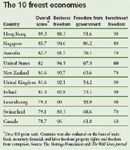Article
Update
Professional and financial news you can use.
TECHNOLOGY
Free e-prescribing software for all

INVESTING
More dollars are headed to the Far East . . .
Where once Europe reigned supreme, countries in Asia and the Pacific region are now the darlings of equity investments beyond our borders. From 2000 to 2003, the ratio of dollars directed to Europe compared to the Asia/Pacific region was 4 to 1, according to Goldman Sachs. Over the next two years, from 2004 to 2005, the ratio changed to 3 to 2 in favor of the Far East. (Figures for 2006 weren't complete but show much the same pattern.)
....and for good reason

HOSPITALS
Overcrowding still an issue at many hospitals
More than one in four hospitals has had to postpone or cancel surgeries because of bed shortages, according to the results of a new survey of hospital executives, administrators, and managers. Overcrowding-which seven out of eight respondents said has not improved in the last year-continues to force hospitals to divert patients needing urgent medical care to other facilities. Moreover, a majority of the hospital administrators who responded said that while their hospital tries to admit patients from their ED within two hours of arrival, 48 percent were unable to meet that goal more than half the time. On a positive note, however, 94 percent of executives and administrators say they believe that technology can help reduce overcrowding, either by itself or in combination with changes in staff and processes.
The survey was commissioned by the American College of Emergency Physicians and TeleTracking Technologies, a Pittsburgh-based producer of patient-flow software for acute care hospitals.





